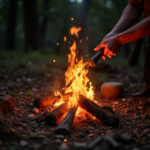Finding north at night is an essential survival skill, and understanding how to do it without a compass can be a lifesaver. Whether you’re lost in the wilderness, navigating while camping, or simply enjoying a night under the stars, these simple techniques will guide you to true north.
Why Finding North at Night is Crucial
Knowing your direction at night ensures you stay on course and avoid getting lost. It’s particularly vital for survivalists and preppers who rely on self-reliance in challenging situations. Nighttime navigation helps you establish bearings when landmarks are hidden in the dark.
Additionally, understanding the principles behind these methods boosts your confidence and awareness of the natural world. Here are several techniques to help you locate north after the sun sets.
Use the North Star (Polaris)
The North Star, or Polaris, is a reliable celestial guide to true north in the Northern Hemisphere.
- Find the Big Dipper: Look for this iconic constellation with its distinctive “ladle” shape.
- Trace the Pointer Stars: The two stars at the edge of the Big Dipper’s “bowl” point directly to Polaris.
- Spot Polaris: It’s the brightest star in the constellation Ursa Minor, directly aligned with the Earth’s axis.
This method works well on clear nights, making it a favorite for stargazers and survivalists alike.
Shadow and Stick Method by Moonlight
While primarily a daytime technique, you can adapt the shadow and stick method at night if the moon is bright.
- Plant a Stick Upright: Place a stick in the ground where moonlight creates a clear shadow.
- Mark the Shadow’s Position: Wait about 20 minutes and mark the shadow’s new location.
- Draw a Line Between Marks: This line will point east to west. Stand with your left foot on the first mark and your right foot on the second to face north.
This approach requires patience but is a clever backup when starlight is obscured.
Identify Constellation Movements
Stars appear to move across the sky due to Earth’s rotation. By observing their motion, you can determine direction:
- Stars Rise in the East and Set in the West: Track the movement to confirm cardinal points.
- Orion’s Belt: The three stars of Orion’s Belt align roughly east-west, with the “head” of the hunter pointing northward in the Northern Hemisphere.
Familiarizing yourself with key constellations will enhance your nighttime orientation skills.
Navigate Using the Moon
The moon is another celestial tool for finding north. Here’s how:
- Quarter Moon Phases: During a crescent or quarter moon, the line connecting the tips of the crescent points roughly south in the Northern Hemisphere.
- Full Moon Orientation: At midnight, the full moon is near its highest point in the southern sky.
While less precise than Polaris, the moon’s position can still provide a general sense of direction.
Backup Techniques When the Sky is Obscured
If weather or terrain blocks your view of the sky, use these alternative methods:
- Observe Natural Landmarks: Moss often grows on the north side of trees, though this varies with climate.
- Wind Patterns: Prevailing winds in your region may offer clues to cardinal directions.
- Compass Alternatives: A makeshift compass can be created using a needle, magnet, and water, aligning with Earth’s magnetic field to show north.
Practicing Nighttime Navigation Skills
To master these techniques, practice during clear nights and familiar surroundings. Combine multiple methods to confirm accuracy, and always carry a reliable backup like a compass or GPS when possible.
Final Thoughts
Finding north at night is simpler than it seems when you rely on the stars, moon, and natural clues. By incorporating these techniques into your survival skill set, you’ll be better prepared to navigate confidently in the dark. These methods not only enhance your preparedness but also deepen your connection with the natural world.



